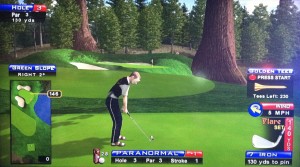Cutting irons into a side pin
By Deprecated: Function the_author_posts_link was called with an argument that is deprecated since version 2.1.0 with no alternative available. in /var/web/site/public_html/wp-includes/functions.php on line 6121 Golden Tee Fan • Category: Approach shots with irons • • Leave a Comment (0)In this article, I’ll talk about situations where the pin is on the side of the green and the wind is blowing away from the flag. A safe play here can be to thumb the ball out to the side and let the wind take the ball back towards the center of the green, but you’ll often find yourself with a long putt and reduce your chance at birdie. Often times the better play is to cut the ball into the flag, but you must do so with caution.
Let’s talk to the following setup, which provides a decent example of where an overcut could be disasterous (click to enlarge):

As mentioned, the safe play could be clubbing down to an 8-iron and thumbing the ball out to the right with bite. Another play could be the 7-iron with backspin thumbed out to the right. You’ll probably stick the green, but your putt could be longer than you like. Then again, the wind could catch it and pull the ball in the sand. Or, you could overdo it and hang it out right too long, finding water.
This example provides an opportunity to practice a 7-iron B1-type shot with backspin. You still want the ball to end up at center, but you want to start it out to the left so it cuts back right into the wind, centering the ball. So how do you know the right angles here to make it work?
First, you can review this article on B1 and B3 shots with different clubs. The biggest takeaway here is that low-lofted irons will cut across center, while higher lofted clubs won’t quite make it back to center. The 7-iron seems to come back right about center in both cases, with no wind.
That means that if we played a B1 here, it wouldn’t come back to center because of the left-blowing wind. The least-costly mistake would be playing that shot, which would end up on the left side of the green (likely about the same place as a thumb shot out right a bit).
The most costly shot, and what I see newer players do, is to pull back too far left of center. The shot might look pretty good at first, but you need to consider what’s going to happen AFTER the ball lands. With backspin, it’s still going to come to the right quite a ways, and here’s where a seemingly good shot might backspin off the right side of the green into the water.
The correct play here is to pull back just slightly left of center and shoot most of the way out to 1 with backspin. This gets the cut you need to counteract the wind, puts the ball on the back middle of the green just left of center, and the backspin pulls it the rest of the way right to center.
You’ll be punished by a miss here more often with the lower-lofted irons, which tend to cut more than you expect (especially while you are still fairly new to the game). If you had this same shot with a 5-iron, for instance, the better play would be the straight back to B and out to 1 shot. A 5-iron cuts back into the wind more forcefully, and in this setup, that shot should put you right on center.
Safe is good, and finding the middle of the green keeps you out of trouble. But as you hone your skills, keep practicing these B1 and B3-type shots, keeping the loft of the iron in mind to help you know how much cut to apply. And if you’re using backspin, err to the middle of the green!

